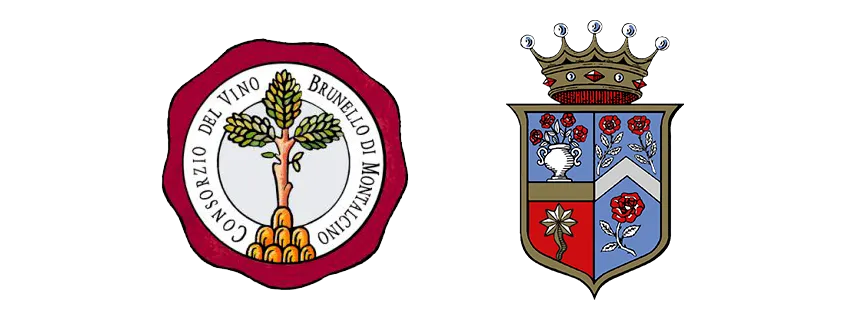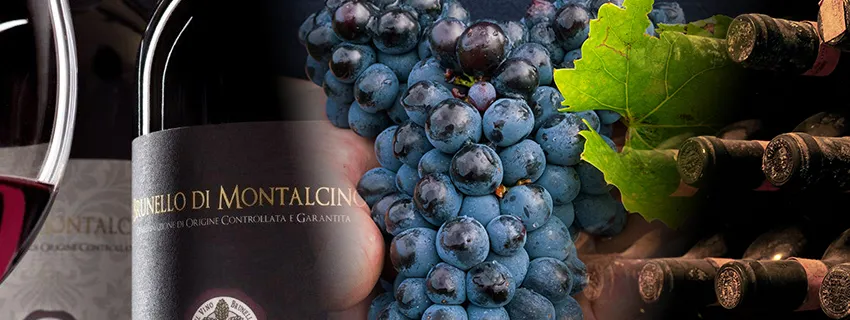Published:
Author: Antonio Maria Guerra
How Is Brunello di Montalcino Made?

How is Brunello di Montalcino is made? In this article we will find out a procedure dating back to the mid-19th century, when the pharmacist Clemente Santi bet on the characteristics of a particular variety of Sangiovese grapes, Sangiovese Grosso, both in terms of body and aging, giving life to one of the standard-bearers of the Italian winemaking tradition. Enjoy the reading!

How is Brunello di Montalcino made?
The vinification process (and subsequent aging) of Brunello di Montalcino does not differ much from that of any other red wine (‘vinification in red’), except for a few details. Here follow a brief explanation of the various steps (click here for the printable version):

01. Brunello di Montalcino is produced using only Sangiovese grapes. The harvest is carried out strictly by hand and generally takes place at the end of September;

02. The bunches of grapes are de-stemmed (the berries are separated from the stalk) using a de-stemmer. After a thorough selection, the grapes are gently pressed to get the must.

03. The must is poured into large stainless steel containers and is left inside of them for a few days at a controlled temperature of about 7° C, thus allowing the cryomaceration to take place (*1);

04. After the cryomaceration, thanks to selected yeasts, the fermentation begins: this leads to a progressive transformation of the sugar into alcohol. During this phase, ‘pumping overs’ (*2) and ‘breaking ups’ (*3) are usually performed;

05. During the fermentation takes place also the maceration. Thanks to this process (among other things), the skins and the grapeseeds release the tannins that characterize Brunello so much;

06. The racking phase follows: using a ‘soft’ press, the solid part of the must is gently separated from the liquid one (the wine);

07. A new fermentation is started (always in steel containers), the ‘malolactic’ fermentation: using a particular type of bacteria, the malic acid present in the wine is transformed into lactic acid;

08. The ‘aging’ period begins: the wine is placed in oak barrels where it will remain for at least two years. The following refinement in the bottle must last instead at least four months (or six in the case of the ‘Riserva’);
It’s important to stress the fact that Brunello di Montalcino cannot be marketed before at least five years since the harvest. In the case of ‘Riserva’ wine, at least six are required.
Notes:
*1: ‘Cryomaceration’, also known as ‘cold maceration’, leads to the extraction of a greater quantity of substances from the solid part of the grape: this improves the organoleptic characteristics of the wine;
*2: The ‘pumping over’ is a cellar technique that consists in extracting a part of the must from the lower part of the stainless steel silos in which it is fermenting, pumping it to the top, where the pomace (the solid part) floats. This technique is used to accelerate the extraction of tannin, color and aromas from grape skins;
*3: The ‘breaking ups’ consist of mechanically breaking the layer of pomace (‘cap’) that forms in the upper part of the must during fermentation, re-immersing the fragments in the must itself. This technique leads to greater aeration and acceleration of alcoholic fermentation;
Let’s find out the fascinating origins of Brunello di Montalcino, as well as a large number of information and interesting facts. To read the article, please click on this LINK.
How is Brunello di Montalcino made?
Printable infographic.
Click HERE to view (and, eventually, download) a printable infographic showing the steps necessary to produce Brunello di Montalcino.


Music by Puccini for Brunello di Montalcino.
The music of Giacomo Puccini, one of the most famous Italian composers, to accompany the reading of an article dedicated to Brunello.


The organoleptic characteristics of Brunello.
Here follows a shortlist of the main organoleptic characteristics of Brunello di Montalcino (these clearly are just generic references):
- Color: ruby red, tending to garnet with aging;
Read more
- On the nose: intense and elegant. It has hints of wild berries, ripe red fruit, vanilla, tobacco, cocoa, leather, and spices;
- In the mouth: dry and warm. Structured, robust, harmonious, and persistent. It has notes of berries, ripe red fruit, coffee, and vanilla. The freshness (acidity) and tannins tend to soften with aging;

How to serve Brunello di Montalcino.
The method of serving wine is generally considered very important: in the case of a product of great value and complexity such as Brunello di Montalcino, it’s fundamental. It must, in fact, allow the harmonious bouquet of the specialty to express at its best.
Read more
It will therefore be necessary to open the bottle at least an hour before tasting: many experts advise against the use of the decanter because it could cause too fast oxygenation.
The temperature must be 18°/20°. The glass is large, round, such as to allow the Brunello to breathe and spread its aromas.

How is Brunello di Montalcino made?
The pairings.
Brunello di Montalcino is a wine of great structure, elegance, and balance, that goes best with equally structured dishes.
Read more
Its tannin and acidity, also when softened by long aging, are perfect to accompany succulent foods (such as grilled or braised meat) or fatty (such as aged cheese). It’s also a good match with pasta, dressed with full-bodied sauces, and risotto, with mushrooms or truffles.

How is Brunello di Montalcino made? The best vintages.
Some vintages of Brunello di Montancino, thanks to particularly favorable climatic conditions, reach peaks of particular excellence.
Since 1945, every January, a special Tasting Commission assigns a vote to the wine produced during the last harvest. This rating is expressed in stars, from one (insufficient) to five (exceptional).
The vintages that, up to now, have achieved the coveted ‘fifth star’ are, in order: 1945, 1955, 1964, 1970, 1975, 1985, 1988, 1990, 1995, 1997, 2004, 2006, 2007, 2010, 2012, 2015, 2016 in 2019 and 2020.

Brunello di Montalcino, the first Italian DOCG.
Since its birth, a product of great value and tradition such as Brunello di Montalcino needed a form of legal protection to defend its peculiar characteristics from the many imitation attempts.
Read more
For this reason, in 1966 it was assigned the Controlled Designation of Origin (DOC), which was followed, in 1980, by the attribution of the first Italian Controlled and Guaranteed Designation of Origin (DOCG) (together with the Vino Nobile di Montepulciano).

The price of Brunello di Montalcino.
Although it’s possible to buy bottles of Brunello di Montalcino at affordable prices, some can reach extremely high prices.
Read more
To explain this difference, it’s necessary to remember that the most valuable ones are the result of a maniacal selection of the grapes, of great care and decades of aging: factors of fundamental importance to let the wine express itself at its best. That said, it should not surprise that some bottles, produced by certain companies in particular vintages, can easily exceed the cost of $ 50,000 !

The product specification and the Consortium.
TThe assignment of the Controlled Designation of Origin (DOC) to Brunello di Montalcino, which took place in 1967, coincided with the drafting of the product specification (‘Disciplinare’).
Read more
This contains the rules for the production of the wine and its requirements. The assignment also led to the foundation of the Consortium, the association of producers which, among its main tasks (*1), has that of supervising compliance with the specification. The document is available at this address.

The producers of Brunello: contacts.
Consorzio del Vino Brunello di Montalcino
Address: Via Boldrini, 10, 53024 Montalcino (Siena) – ITALY
Official website: Click here
Mail: Click here
Tel.: +39 0577 848246
FAX: +39 0577 849425
Biondi-Santi.
Address: Villa Greppo, 183, 53024 Montalcino (Siena) – ITALY
Official website: www.biondisanti.it
Mail: biondisanti@biondisanti.it
Tel.: +39 0577 848023
FAX: +39 0577 849396
Copyright information.
The images displayed in this page belong to WebFoodCulture, to the Consorzio del Vino Brunello di Montalcino and to Biondi-Santi S.p.a., with the exception of:
Public Domain image
- 500 United States dollars bill (Wikipedia Link) {PD-US}
- Giacomo Puccini, 1908 (Wikipedia Link)
- Piano score to Puccini’s opera Tosca, 1899 (Wikipedia Link) {PD-Art}


